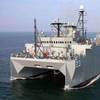Diginonymous, GW Partner for Offshore Medical Software
Software developer Diginonymous LLC and Maritime Medical Access Program at The George Washington University (GW) Medical Faculty Associates have teamed up to offer an advanced shipboard video telemedicine service for the international maritime industry to help clients meet the International Labor Organization’s (ILO) Maritime Labor Convention (MLC) 2006 requirements for crew healthcare.
The GW Maritime Medical Access Program and Diginonymous developed the Digi+Doc service, a maritime medical solution leveraging GW’s decades of experience and Diginonymous’ products to provide immediate, round-the-clock phone and video medical consults for ships at sea. Digi+Doc subscribers, including current shipowners such as Maersk Line, Limited, have immediate access to a team of more than 550 physicians and specialists at the GW Medical Faculty. The use of Digi+Doc as an innovative way to meet the MLC 2006 healthcare requirements is being showcased at the Nor-Shipping exhibition in Oslo this week.
Digi+Doc communications systems are based on the DigiGone software platform, which offers low-cost, encrypted video and audio conferencing, video streaming, Voice over IP (VoIP), IM Chat and file transfer, optimized for maritime satellite channels. The DigiGone software installs on most PCs, laptops, tablets or smartphones. It can work over VSAT, Inmarsat, Thuraya IP and other networks, with satellite airtime costs much lower than other commercial teleconferencing services, such as Skype.
In addition to teleconferencing, Diginonymous’ Remote Viewing Station (RVS) for Telemedicine enhances a vessel’s ability to access medical services and transmit medical data. The kit facilitates the real-time transmission of data from the ship to a remote clinician through instruments such as a handheld electrocardiogram device, blood pressure machine, electronic thermometer and microscope camera. “Digi+Doc is an ideal solution for shipowners to meet the new international regulations for crew health and medical treatment required by MLC 2006,” said George N. Spohn, Diginonymous’ senior vice president for global sales and marketing. “By offering real-time teleconferencing with experienced emergency physicians, many crew illnesses and injuries can be treated onboard without an expensive helicopter evacuation or port diversion.”
Title 4 of MLC 2006 requires that health protection and medical care for seafarers must be as compatible as possible to that which is generally available to workers ashore, including prompt access to the necessary medicines, medical equipment and facilities for diagnosis and treatment, and to medical information and expertise. Having been ratified by more than 30 member states reflecting more than 33% of world gross tonnage, MLC 2006 comes into effect Aug. 20, 2013. This comprehensive document applies to more than 1.2 million seafarers, including those working on ships whose flag states have not ratified the Convention.
“There is general agreement among emergency clinicians that seeing the patient greatly improves correct diagnosis and treatment for illnesses or injuries,” said James Betz, program manager, Maritime Medical Access. “The combination of real-time diagnostic sensor readings with a visual inspection of the patient can reduce misdiagnosis or over-triaging a problem, increasing the likelihood that the vessel will stay on course and not have to divert for a medical emergency. With follow-up teleconferences, the remote physician can determine when the crew member can safely resume work.”
Spohn noted that the DigiGone video software and hardware kit can also be used for other shipboard applications such as troubleshooting equipment failures and real-time anti-piracy security, in addition to telemedicine.
All that’s needed for shipowners to take advantage of Digi+Doc is to install the DigiGone software on a shipboard computer, and sign up for an annual subscription to the Maritime Medical Access Service at GW.
“The entire cost of the system, including software license, medical access subscription and satellite airtime, is far less than the expense of a single incident requiring medical evacuation or port diversion,” Spohn said. “In addition, the telemedicine service can reduce time off for a sick or injured crew member, and will provide important documentation in the event of a crew claim.”
www.digigone.com
www.gwemed.edu/maritime












